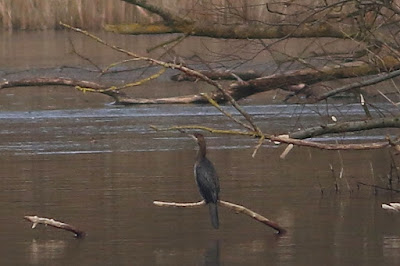I have resisted Euro-twitching for similar reasons to why I have never twitched Ireland - first, it's a long way away and, second, it feels like a slippery slope from which, once descended, there might be no easy return. This self-denying ordnance came under some theoretical pressure in January when a Spectacled Eider - a globally rare species which would ordinarily require a trip to Alaska/NE Siberia to be seen on its breeding grounds - was located on the Dutch island of Texel.
 |
| Spectacled Eider |
 |
| A wider angle of the shot above |
I say theoretical as my only realistic opportunity to go was with a group of friends soon after the bird was discovered - but this was compromised by the fact that my wife was away on a hen weekend, and my son needed me at home to help practice for a forthcoming driving test. Besides, the thought of squeezing such a trip into a weekend really didn't appeal, and I put it from my mind.
 |
| Spectacled Eider, 18th February |
 |
| Spectacled Eider, 18th February |
February half-term is normally reserved for crazy long bike rides but as the holiday approached there was not much going on locally on the bird front, and I was reminded of an earlier, very speculative conversation with fellow Dorset birder Steve Smith about a Texel trip. Steve had been overseas so we didn't seriously discuss any kind of plan before Sunday 16th. By the time we did, I had complicated things somewhat by sounding out Claire and Rowan about combining the Texel trip with an Amsterdam city break. Although it would multiply both the complexity and cost of the trip by a factor of about 10, it would make me feel better about the birding trip if they agreed to meet me there.
 |
| A wing-flap from the Spectacled Eider... |
 |
| ...and a short flight |
They were initially keen but indecisive, though after several changes of heart a positive decision to go was made. We assessed multiple permeations on how best to do it and the plan eventually solidified as follows: I would head off with Steve on Monday night to get the Harwich-Hook of Holland ferry and visit Texel before meeting the family in Amsterdam on the Wednesday afternoon, and we would then travel back together on the Friday night.
 |
| The Spectacled Eider remained distant throughout our visit but in good light |
 |
| A remarkable record |
Within an hour of the decision being made, arrangements had been made and credit cards maxed out. Steve picked me up on Monday afternoon and after a fairly horrendous journey around the M25 we made it to the Harwich ferry with over an hour to spare. This was a bit more expensive than the shorter crossing at Dover, but would cut out a lot of driving and offered the luxury of a good night's sleep in a cabin. That enabled us to arrive at the Hook of Holland on Tuesday morning refreshed and ready for the 2 hour drive to Den Helder, from where the ferry for Texel would depart.
 |
| Redwing, Texel |
 |
| Fieldfare, Texel |
The Texel ferry, a community-run, not-for-profit service, was pretty impressive and served a mean tomato soup for an early lunch. In no time at all we were disembarking and heading up the east coast of Texel to the towering seawall at Lancasterdijk, temporary residence of the Spectacled Eider. Texel was an amazing landscape of polders and dykes and a testament to Dutch coastal engineering, the impudence of which became obvious from the top of the Lancasterdijk where the sea in front could be seen quite a bit higher then the land behind.
 |
| Brent Goose, Texel |
 |
| Barnacle and White-fronted Geese, Texel |
It was a bitterly cold day with a biting wind, but I was well wrapped up and within a few seconds of sitting down on top of the seawall had located the Spectacled Eider in my scope. Although it was a good way out, the bird was every bit as impressive as legend had it, smaller than the Common Eider with which it is was loosely associating, but easy to pick out with an orange bill, large white 'spectacle' over the eye with black surround, brown patches in front of the eyes and a subtle sage green behind. We watched the bird for a couple of hours, following it down the seawall as it drifted south-west. This eventually brought it to a protruding stretch of seawall which meant it was slightly closer, and from where I was able to get a few record shots with a 1.4x converter on a 100-400mm lens.
 |
| Shoveler on the ice on Texel |
 |
| Eider near the Spectacled Eider |
Steve headed off for something to eat leaving me keeping watch, during which time the Spectacled Eider flew back north-east, providing for a few flight shots to be added to the collection. By the time Steve returned it was getting colder so we warmed up in the car and went on a bit of a goose chase around Texel, catching up with huge flocks of Barnacle, Brent, White-fronted and Greylag Geese as sunset approached.
 |
| White-fronted and Barnacle Geese, Texel |
 |
| White-fronted Geese, Texel |
We went to Lancasterdijk for the last 'golden hour' of light, hoping the Eider would be closer - it wasn't, but scope views were excellent with the sun right behind us. It had been a successful start to the trip and we retired to the town of De Koog for a decent meal and a night in a very reasonably priced hotel.
 |
| Spectacled Eider in flight near a Common Eider |
 |
| White-fronted and Greylag Geese at sunset on Texel |






























































